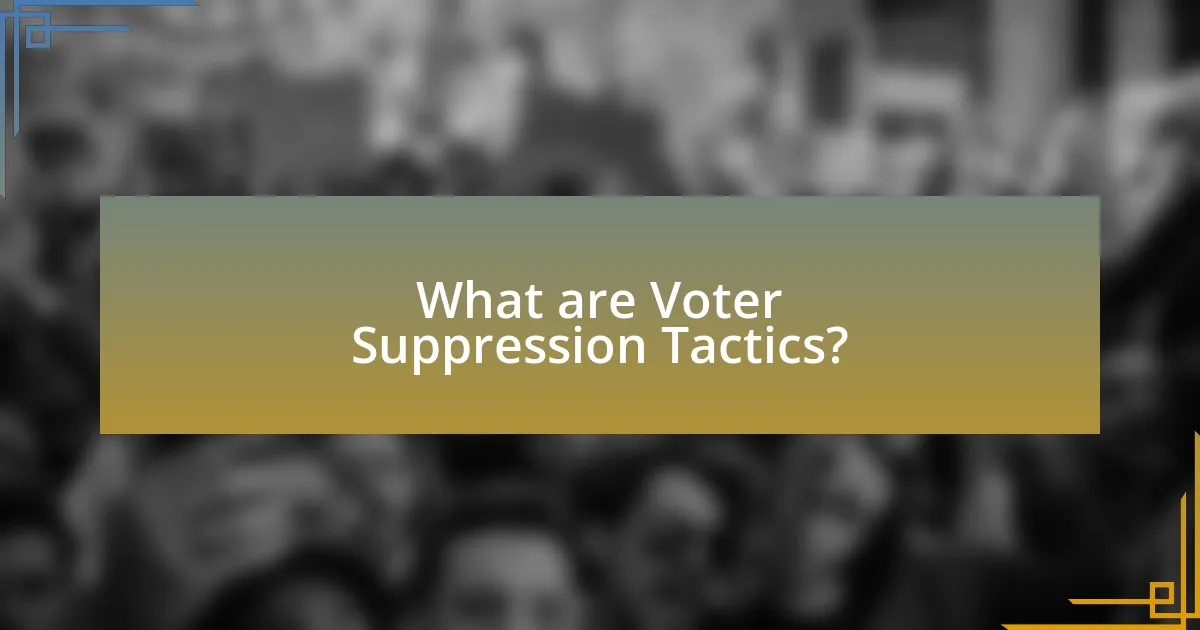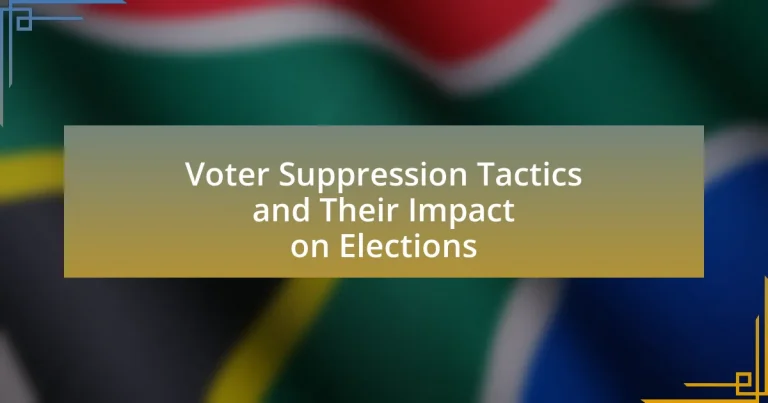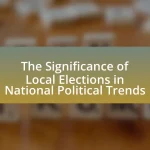Voter suppression tactics refer to strategies designed to discourage or prevent specific groups from participating in elections, significantly impacting voter turnout and the democratic process. Common methods include strict voter ID laws, purging voter rolls, reducing polling places, and limiting early voting, which disproportionately affect racial minorities, low-income individuals, and young voters. The article explores the historical context, regional variations, political motivations, and socioeconomic factors influencing these tactics, as well as their effects on election outcomes. It also examines legal frameworks aimed at combating voter suppression and highlights the role of advocacy groups in raising awareness and mobilizing communities to protect voting rights.

What are Voter Suppression Tactics?
Voter suppression tactics are strategies employed to discourage or prevent specific groups of people from voting. These tactics can include strict voter ID laws, purging voter rolls, reducing polling places in certain areas, limiting early voting, and implementing onerous registration requirements. For instance, a study by the Brennan Center for Justice found that states with strict voter ID laws saw a significant decrease in voter turnout, particularly among minority groups. These tactics aim to manipulate electoral outcomes by disenfranchising eligible voters, thereby impacting the overall democratic process.
How do Voter Suppression Tactics manifest in elections?
Voter suppression tactics manifest in elections through various methods aimed at reducing voter turnout among specific demographics. These tactics include strict voter ID laws, which disproportionately affect minorities and low-income individuals; purging voter rolls, often targeting those who have not voted in recent elections; and limiting access to polling places, resulting in long lines and reduced voting opportunities. For example, a study by the Brennan Center for Justice found that states with strict voter ID laws saw a decrease in turnout by as much as 2-3% among eligible voters. Additionally, the U.S. Election Assistance Commission reported that over 1.1 million voters were removed from voter rolls in 2016, often without adequate notice. These actions collectively create barriers that hinder the ability of certain groups to participate in the electoral process.
What are the most common methods of Voter Suppression?
The most common methods of voter suppression include voter ID laws, purging of voter rolls, limited access to polling places, and restrictions on early voting and mail-in ballots. Voter ID laws require individuals to present specific forms of identification, which disproportionately affects minority and low-income voters who may lack such IDs. Purging voter rolls can lead to eligible voters being removed without their knowledge, often targeting specific demographics. Limited access to polling places results in long lines and increased difficulty for voters, particularly in urban areas. Additionally, restrictions on early voting and mail-in ballots can reduce opportunities for participation, especially for those with rigid work schedules or mobility issues. These tactics have been documented in various studies, including the Brennan Center for Justice’s report on voter suppression, which highlights the negative impact these methods have on electoral participation.
How do these tactics vary by region or state?
Voter suppression tactics vary significantly by region and state, influenced by local laws, demographics, and political climates. For instance, Southern states like Georgia and Texas have implemented strict voter ID laws and purged voter rolls, targeting minority populations, while states in the Northeast, such as New York, have more lenient voting regulations and expanded access to early voting. Research from the Brennan Center for Justice indicates that states with a history of discriminatory practices often adopt more aggressive suppression tactics, such as limiting polling places and reducing voting hours, which disproportionately affect low-income and minority voters. This regional disparity highlights how local governance shapes the accessibility of voting and the overall electoral landscape.
Why are Voter Suppression Tactics employed?
Voter suppression tactics are employed to limit or restrict the ability of specific groups of people to participate in elections. These tactics are often aimed at marginalized communities, including racial minorities, the elderly, and low-income individuals, to influence electoral outcomes in favor of particular political interests. Historical evidence shows that measures such as strict voter ID laws, purging voter rolls, and reducing polling places disproportionately affect these groups, thereby reducing their voter turnout. For instance, a study by the Brennan Center for Justice found that states with strict voter ID laws saw a significant decrease in voter participation among minority populations, highlighting the effectiveness of these tactics in shaping election results.
What political motivations drive the use of Voter Suppression?
Voter suppression is primarily driven by political motivations aimed at maintaining power and control over electoral outcomes. Political parties or groups may implement voter suppression tactics to limit the participation of demographics that tend to vote against them, thereby skewing election results in their favor. For instance, studies have shown that measures such as strict voter ID laws disproportionately affect minority and low-income voters, who historically lean towards certain political parties. According to a report by the Brennan Center for Justice, states that enacted voter suppression laws saw a significant decrease in voter turnout among these groups, illustrating the effectiveness of such tactics in achieving political objectives.
How do socioeconomic factors influence Voter Suppression strategies?
Socioeconomic factors significantly influence voter suppression strategies by determining access to resources and information necessary for voting. Individuals from lower socioeconomic backgrounds often face barriers such as limited access to transportation, lack of flexible work hours, and insufficient knowledge about voting procedures, which can be exploited through restrictive laws and practices. For instance, states with higher poverty rates may implement strict voter ID laws that disproportionately affect low-income individuals, as seen in studies showing that these laws reduce turnout among marginalized groups. Additionally, socioeconomic disparities can lead to targeted efforts to limit early voting and polling locations in areas predominantly inhabited by low-income populations, further suppressing their electoral participation.
What are the historical contexts of Voter Suppression Tactics?
Voter suppression tactics have historically emerged in response to social and political movements aimed at expanding voting rights. In the United States, significant examples include the post-Civil War implementation of Jim Crow laws, which enforced racial segregation and disenfranchised African American voters through literacy tests, poll taxes, and understanding clauses. These laws were designed to maintain white supremacy in the electoral process and were upheld by the Supreme Court in cases like Plessy v. Ferguson (1896).
Additionally, during the 20th century, voter suppression tactics evolved with the introduction of measures such as gerrymandering and voter ID laws, often justified under the guise of preventing fraud. The Voting Rights Act of 1965 aimed to eliminate many of these discriminatory practices, but subsequent Supreme Court decisions, such as Shelby County v. Holder (2013), weakened federal oversight, leading to a resurgence of voter suppression efforts in various states. These historical contexts illustrate a persistent struggle over voting rights and the tactics employed to suppress certain populations from participating in elections.
How have Voter Suppression Tactics evolved over time?
Voter suppression tactics have evolved from overt methods, such as literacy tests and poll taxes, to more subtle strategies, including voter ID laws and purging voter rolls. Historically, literacy tests and poll taxes were used primarily in the Jim Crow South to disenfranchise Black voters until the Voting Rights Act of 1965 prohibited such practices. In recent decades, tactics have shifted towards legislation that requires specific forms of identification to vote, which disproportionately affects minority and low-income populations. For instance, a 2018 study by the Brennan Center for Justice found that strict voter ID laws can reduce turnout by as much as 3-5%, particularly among marginalized groups. Additionally, the practice of purging voter rolls has increased, with states removing millions of voters from registration lists, often without adequate notification. These evolving tactics reflect a continuous effort to influence electoral outcomes by limiting access to voting for certain demographics.
What significant events have shaped current Voter Suppression practices?
Significant events that have shaped current voter suppression practices include the Voting Rights Act of 1965, the Supreme Court’s decision in Shelby County v. Holder (2013), and various state-level legislative actions following the 2020 presidential election. The Voting Rights Act aimed to eliminate barriers to voting for African Americans, but the Shelby County decision invalidated key provisions, leading to a resurgence of restrictive voting laws in several states. For instance, after this ruling, states like Georgia and Texas enacted laws that impose stricter voter ID requirements and limit early voting, which disproportionately affect minority voters. Additionally, the aftermath of the 2020 election saw numerous states introduce laws that further restrict mail-in voting and voter registration processes, reflecting ongoing efforts to suppress voter turnout among specific demographics.
How do Voter Suppression Tactics impact voter turnout?
Voter suppression tactics significantly decrease voter turnout by creating barriers that hinder individuals from exercising their right to vote. These tactics include strict voter ID laws, purging voter rolls, reducing polling places, and limiting early voting opportunities, which disproportionately affect marginalized communities. For instance, a study by the Brennan Center for Justice found that states with strict voter ID laws saw a 2-3% drop in turnout among eligible voters, particularly among minorities and low-income individuals. This evidence illustrates that voter suppression tactics not only discourage participation but also exacerbate existing inequalities in the electoral process.
What demographic groups are most affected by Voter Suppression?
Voter suppression primarily affects racial and ethnic minorities, low-income individuals, and young voters. Studies indicate that African Americans, Latinos, and Native Americans face significant barriers such as strict voter ID laws, reduced polling places, and purging of voter rolls. For instance, a 2018 report by the Brennan Center for Justice highlighted that states with strict voter ID laws disproportionately impacted African American voters, who are less likely to possess the required identification. Additionally, low-income individuals often struggle with access to polling locations and resources, while young voters frequently encounter obstacles like registration deadlines and lack of information. These demographic groups experience systemic challenges that hinder their ability to participate in elections effectively.
How does Voter Suppression influence election outcomes?
Voter suppression significantly influences election outcomes by reducing voter turnout, particularly among marginalized groups. Studies indicate that tactics such as strict voter ID laws, purging voter rolls, and limiting polling places disproportionately affect minority and low-income voters, leading to lower participation rates. For instance, a 2016 report by the U.S. Commission on Civil Rights found that states with strict voter ID laws saw a decrease in turnout by as much as 2-3% among eligible voters. This reduction in participation can shift election results, often favoring candidates who benefit from lower turnout among opposition demographics.
What legal frameworks exist to combat Voter Suppression?
The legal frameworks that exist to combat voter suppression include the Voting Rights Act of 1965, the National Voter Registration Act of 1993, and various state laws aimed at protecting voter access. The Voting Rights Act prohibits discriminatory voting practices and requires jurisdictions with significant racial discrimination histories to obtain federal approval before changing voting laws. The National Voter Registration Act mandates states to offer voter registration opportunities at the same time as applying for a driver’s license or public assistance. Additionally, many states have enacted laws that enhance voter access, such as same-day registration and extended voting hours, to counteract suppression tactics.
What laws have been enacted to protect voting rights?
The Voting Rights Act of 1965 is a key law enacted to protect voting rights in the United States. This legislation aimed to eliminate various forms of racial discrimination in voting, particularly in Southern states, by prohibiting literacy tests and other discriminatory practices. Additionally, the National Voter Registration Act of 1993, also known as the Motor Voter Act, was enacted to enhance voter registration opportunities and ensure that all citizens have access to the electoral process. These laws have been instrumental in safeguarding the voting rights of marginalized groups and have been upheld by various Supreme Court rulings that affirm their importance in promoting fair electoral practices.
How effective are these laws in preventing Voter Suppression?
These laws are moderately effective in preventing voter suppression, as they aim to enhance access to voting and protect against discriminatory practices. For instance, the Voting Rights Act of 1965 significantly reduced barriers for minority voters, evidenced by increased voter registration and turnout among these groups in subsequent elections. However, recent legislative changes in various states have introduced new restrictions, such as voter ID laws and purging of voter rolls, which can counteract the protections intended by these laws. Studies indicate that states with stricter voting laws often see lower participation rates, particularly among marginalized populations, highlighting the ongoing challenges in fully preventing voter suppression despite existing legal frameworks.
What role do advocacy groups play in addressing Voter Suppression?
Advocacy groups play a crucial role in addressing voter suppression by mobilizing public awareness, providing legal assistance, and influencing policy changes. These organizations, such as the NAACP and the ACLU, actively work to identify and challenge laws and practices that disenfranchise voters, particularly marginalized communities. For instance, the ACLU has successfully litigated against voter ID laws that disproportionately affect minority voters, demonstrating their effectiveness in combating suppression tactics. Additionally, advocacy groups conduct outreach campaigns to educate voters about their rights and the voting process, which is essential in countering misinformation and barriers to access. Their efforts contribute significantly to increasing voter turnout and ensuring fair electoral practices.
How do these groups mobilize communities against Voter Suppression?
Groups mobilize communities against voter suppression by organizing grassroots campaigns that raise awareness about voting rights and the tactics used to suppress votes. These organizations often conduct outreach programs, provide educational resources, and facilitate community meetings to inform citizens about their rights and the importance of participation in elections. For example, the NAACP and the ACLU have historically engaged in voter registration drives and legal challenges to discriminatory laws, demonstrating their commitment to combating voter suppression. Additionally, data from the Brennan Center for Justice indicates that states with active community mobilization efforts see higher voter turnout, reinforcing the effectiveness of these groups in empowering communities to resist suppression tactics.
What strategies do advocacy groups use to raise awareness?
Advocacy groups use various strategies to raise awareness about voter suppression tactics and their impact on elections. These strategies include grassroots mobilization, social media campaigns, public education initiatives, and partnerships with other organizations. Grassroots mobilization involves organizing community events and rallies to engage citizens directly, while social media campaigns leverage platforms like Twitter and Facebook to disseminate information rapidly and widely. Public education initiatives often include workshops and informational sessions that inform voters about their rights and the tactics used to suppress their votes. Partnerships with other organizations enhance outreach efforts by combining resources and networks, thereby amplifying the message. For instance, the American Civil Liberties Union (ACLU) has effectively utilized these strategies to inform the public about voter ID laws and their implications, demonstrating the effectiveness of coordinated advocacy efforts in raising awareness.
What are the future implications of Voter Suppression Tactics on elections?
Voter suppression tactics will likely lead to decreased voter turnout and increased polarization in future elections. Historical data indicates that states implementing strict voter ID laws and purging voter rolls have seen significant declines in participation, particularly among minority and low-income populations. For example, a study by the Brennan Center for Justice found that voter ID laws could disenfranchise up to 11% of eligible voters in certain demographics. This trend may result in elections that do not accurately reflect the will of the populace, potentially undermining the legitimacy of electoral outcomes and exacerbating divisions within society.
How might emerging technologies affect Voter Suppression efforts?
Emerging technologies can significantly mitigate voter suppression efforts by enhancing voter access and engagement. For instance, online voter registration and mobile voting applications can simplify the registration process, making it easier for marginalized groups to participate in elections. A study by the Pew Research Center found that states with online registration saw a 10% increase in voter registration rates. Additionally, technologies such as blockchain can improve the security and transparency of voting systems, reducing the likelihood of fraudulent practices that often accompany voter suppression tactics. These advancements not only empower voters but also create a more equitable electoral process.
What trends should we watch for in the fight against Voter Suppression?
Key trends to watch in the fight against voter suppression include the rise of legislation aimed at expanding voting access, increased grassroots mobilization efforts, and the use of technology to enhance voter registration and education. Recent data shows that states like California and New York have implemented automatic voter registration, which has significantly increased voter participation rates. Additionally, organizations such as the NAACP and ACLU are actively working to combat restrictive laws through legal challenges and public awareness campaigns, highlighting the importance of community engagement in countering suppression tactics. The ongoing analysis of voter turnout data will also provide insights into the effectiveness of these initiatives, as seen in the 2020 election where higher turnout was linked to proactive measures against suppression.
What can individuals do to combat Voter Suppression?
Individuals can combat voter suppression by actively participating in voter registration drives and advocating for accessible voting options. Engaging in local organizations that focus on civil rights and voting access can amplify efforts to ensure that marginalized communities are informed about their voting rights. For instance, the National Voter Registration Act of 1993 mandates states to offer voter registration opportunities, which individuals can leverage by promoting these services in their communities. Additionally, individuals can monitor local elections for irregularities and report any suppression tactics to organizations like the Election Protection Coalition, which works to safeguard voting rights.
How can voters educate themselves about their rights?
Voters can educate themselves about their rights by accessing reliable resources such as state election offices, voter advocacy organizations, and legal aid groups. These entities provide comprehensive information on voting rights, including registration processes, identification requirements, and protections against discrimination. For example, the National Association of Secretaries of State offers resources that detail state-specific voting laws, while organizations like the American Civil Liberties Union provide guides on voter rights and how to report violations. Engaging with these resources ensures that voters are informed and can effectively exercise their rights during elections.
What actions can citizens take to support fair voting practices?
Citizens can support fair voting practices by actively participating in voter registration drives and advocating for accessible voting options. Engaging in these actions helps ensure that all eligible voters can exercise their rights. For instance, according to the U.S. Census Bureau, states that implemented automatic voter registration saw increases in voter participation rates, demonstrating the effectiveness of making registration easier. Additionally, citizens can monitor local elections and report any irregularities, which contributes to transparency and accountability in the electoral process. Research from the Brennan Center for Justice indicates that community involvement in election monitoring can deter voter suppression tactics, thereby reinforcing fair voting practices.


